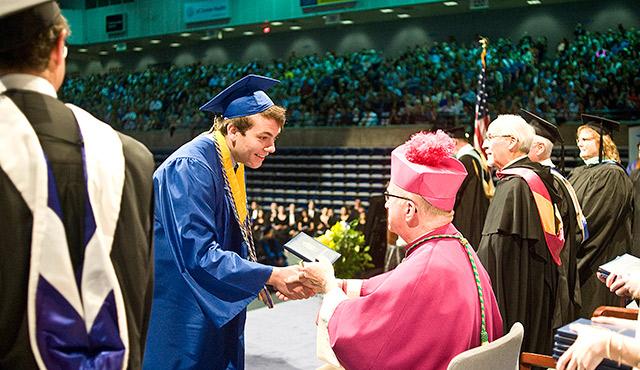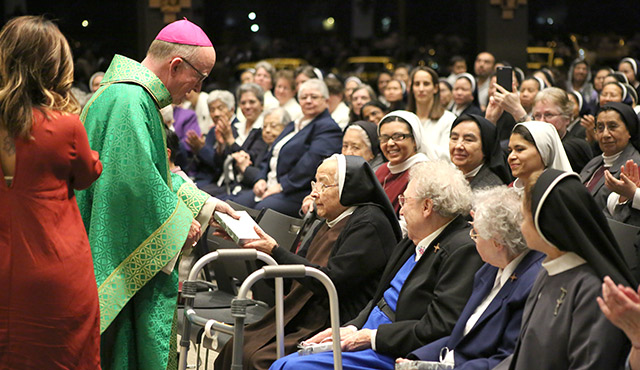The word “diocese” comes from a late Roman Empire term for a relatively small geographic area governed by a civil authority under the allegiance and direction of the Roman prefect, and ultimately the emperor. It was equivalent to today’s county structure – a civil means of delegating certain aspects of day-to-day governance to a regional authority.
When St. Peter preached in Rome, the diocesan structure was in place and familiar to the earliest Christians. The various Pauline Epistles and Acts of the Apostles make this clear; the early Church embraced a similar organization among the various regions that took up the faith. The Church adopted the diocese structure, which was well established by the year 110 AD when St. Ignatius wrote to the Church in Smyrna, “Wheresoever the bishop shall appear, there let the people be, even where Jesus may be, there is the Catholic Church.”
As the Church emerged from the Roman persecutions this structure of local governance under the direction of papal authority solidified. A Catholic diocese, often with the same general boundaries as the Roman civil diocese, became the stabilizing authority to fill the void left when the Roman Empire crumbled.
Most Protestant and Evangelical churches insist on the autonomy of their local church and its own interpretation of biblical teachings, usually by a charismatic pastor who leads the congregation. Depending on its size and resources, a protestant church is a stand-alone operation with all ministries and services contained within one congregation. By contrast, the Roman Catholic Church is clearly directed and governed by the Holy Father and the Magisterium, which is the teaching authority of the church. This ensures the consistency of Catholic theology and interpretation of the Bible and sacred tradition.
According to Father Steven Sallot, vicar general and moderator of the Curia for the Diocese of Orange, “Most Catholics embrace their faith through their local parish, led by a pastor who has been entrusted to his role by the Bishop. In a community like Orange County, with 1.3 million Catholics, a single parish could not possibly provide for all the spiritual and temporal needs of every parishioner.”
For example, the deaf ministry and jail ministry are managed at the Diocesan level. The Diocese of Orange includes 62 parishes and centers, 41 schools and a wide variety of ministries and services. “Bishop Vann gives wide latitude to a pastor to determine the ministries and programs for his parish, with the Diocese acting as a resource and providing some oversight,” Fr. Sallot says.
The ministries are where our Catholic faith goes from being a noun to a verb – faith as an action word. The first stop on the quest to discover the many active ministries in the Diocese is the website: rcbo.org. There are 41 ministry and service categories from cemeteries to vocations, but many include a variety of related services.
Education is the largest ministry of the Diocese. Our excellent elementary and secondary school system is managed by the Diocese under the direction of Gregory Dhuyvetter, superintendent. The schools are fully accredited, as are the teachers. According to the Department of Catholic Schools of the Diocese of Orange, “(Our schools) serves the mission of building the church of tomorrow by supporting schools that provide students with the best Catholic faith formation and the skills and knowledge to live lives of goodness, service, and success.”
In addition to elementary and secondary education, the Diocese operates a large Faith Formation program under the direction of Reverend Gerald Horan, OSM. Faith formation provides in-services, education, training and support for parish and school personnel in Catholic Schools, Faith Formation Programs, Youth & Young Adult Ministry and the Institute for Pastoral Ministry Diocese-wide programs and spiritual enrichment for students, youth, adults and other groups.
Complementing the Faith Formation program is the Institute for Pastoral Ministry, which is college-level certification training for catechists, Catholic school educators, youth ministers, confirmation coordinators, faith formation ministers, volunteers and diaconate aspirants and candidates. The institute is offered in conjunction with several universities including Loyola Marymount and the University of Dayton.
According to Fr. Sallot, “Since we moved to the Pastoral Center at Christ Cathedral, our ability to expand ministries has grown exponentially. It brings people together for workshops, events and training in ways that we could never have done before.” In a sense, the Pastoral Center is where the parish family goes to meet its relatives from throughout the Diocese. “Every Sunday we have more than 10,000 people at the Pastoral Center. The dynamic is much bigger so people can access more than is possible in a neighborhood parish.”
It is important to remember that Jesus founded a single Church with St. Peter as its first leader. Even the Bible, which we believe is the inspired word of God, was not given to us by Jesus directly, but compiled into a canon by His Church several centuries after the Resurrection. Jesus clearly wished His church to have leadership, direction and authority. The resulting structure from the Parish to the Diocese to the Vatican itself has withstood the politics, wars, disasters, plagues and persecutions of two millennia. So, live in and love your parish family because it is from there that we are each called to the mission on behalf of Christ’s Church. But if you are so inclined to stretch your wings to new heights, the Diocese can guide you.


